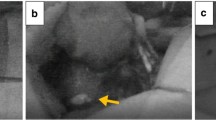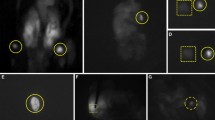Abstract
Purpose
A fluorescence-based technique for the detection of parathyroid glands (PGs) intraoperatively was previously reported. The technique was based on the phenomenon in which PGs emit autofluorescence when exposed to near-infrared light and we undertook an evaluation to consider the pathological accuracy of the method.
Methods
The study comprised 17 patients (18 specimens) who underwent thyroid surgery at Kushiro City General Hospital between November 2018 and June 2019. We searched for PGs intraoperatively using a fluorescence spectroscopy system and evaluated the pathological accuracy of the system. We statistically evaluated the clinical factors associated with the accuracy of the system, including age, gender, body mass index, laterality, disease state, renal function, and comorbidity.
Results
Eighteen specimens were evaluated pathologically, with 13 specimens confirmed as PGs. These were evaluated as “true positive,” giving a positive predictive value of 72.2% (13/18). Among the false-negative cases, one specimen was a metastatic lymph node in a patient with papillary thyroid carcinoma. There was a significant difference in the true-positive rates between malignant (25%) and benign (85.7%) disease (P = 0.044).
Conclusion
We consider that this technique is useful, however, we have to exercise care in malignant cases as the true-positive rate may be low.
Similar content being viewed by others
Avoid common mistakes on your manuscript.
Introduction
Iatrogenic injury of the parathyroid glands (PGs) is the most common complication after total thyroidectomy. It can cause postoperative hypoparathyroidism resulting in severe symptoms and force patients to take calcium and vitamin D on a permanent basis. PGs are often difficult to distinguish from the surrounding tissues as they are small, look like fat tissue, and vary widely in their location. Therefore, several methods for identifying PGs intraoperatively have been reported. In 2011, Paras et al. first reported that PGs emit autofluorescence when exposed to near-infrared light [1]. Since then, there have been a number of reports related to techniques based on the use of fluorescence to detect PGs intraoperatively. These reports indicated that the method was effective clinically [1, 2]. Our study sought to evaluate the accuracy of the fluorescence system pathologically and to determine the clinical factors associated with the accuracy of the system.
Patients and methods
This study was conducted at the Department of Otolaryngology-Head and Neck Surgery, Kushiro City General Hospital between November 2018 and June 2019. In cases undergoing total or hemi thyroidectomy, a surgeon exposed the surgical field to near-infrared light using a fluorescence spectroscopy system “PDE-neo®” (Hamamatsu Photonics Ltd. Shizuoka, Japan). If fluorescence was observed, the tissue was removed and divided into two sections. One was evaluated intraoperatively by frozen sectioning. If that was pathologically identified as a PG, the other was implanted in the sternocleidomastoid muscle. Subjects in whom no fluorescence was observed were excluded.
A total of 17 patients (1 undergoing total thyroidectomy and 16 hemithyroidectomy) were included. This group comprised 6 males and 11 females, with a median age of 66 years (range, 40–78 years). In total, 3 patients (4 sides) had papillary carcinoma, and 14 patients had benign disease (adenomatous goiter in 12 patients, follicular adenoma in 1, and Hashimoto’s disease in 1). Further patient characteristics are shown in Table 1.
Fisher’s exact test was used to assess whether there was a relation between the pathological identification rate and other factors. Factors included age (< 64 or 65 ≤), gender (male or female), body-mass index (BMI < 25 or 25 ≤), laterality (right or left), disease state (benign or malignant), renal function (estimated glomerular filtration rate < 60 or 60 ≤), and comorbidity (diabetes mellitus and cardiovascular disease). A P value < 0.05 was considered statistically significant. Approval for this study was obtained from the Institutional Reviewed Board at Kushiro City General Hospital. Completion of the survey was considered to represent implied consent for participation.
Results
Eighteen areas of soft tissue were detected by the fluorescence spectroscopy system, and evaluated pathologically. Of the 18 specimens, 13 were PGs, and 5 were other tissues (false positive). Therefore, the positive predictive value of the method was 72.2%.
Among the false-positive cases, three specimens consisted of fat tissue and two were lymph nodes (one was benign, the other was a metastatic lymph node from a papillary carcinoma patient). Two of the patients involved had adenomatous goiter and three had papillary carcinoma.
Among the four malignant cases, one specimen was a PG but three were false positive. There was a significant difference in false-positive cases between malignant and benign disease (P = 0.044). No significant differences were observed among the other factors (Table 2).
The preoperative mean value of serum calcium before surgery was 9.31 ± 0.08 mg/dL, while the postoperative mean value was 8.41 ± 0.11 mg/dL.
Discussion
It is difficult to identify PGs visually as they are too small, appear similar to fat tissue and locate in various places. Therefore, PGs were often damaged or removed during thyroid surgery, and a reliable method for detecting PGs during surgery is needed.
After it was reported that PGs emit autofluorescence when exposed to near-infrared light in 2011, a number of studies were undertaken on methods to distinguish PGs using this phenomenon [3]. In this study, the probability that the fluorescent tissue is a parathyroid gland (the true-positive rate) was 72.2%. McWade at el. reported a true-positive rate of 97% [4]. PGs are not visible to the naked eye due to coverage by soft tissue, but the autofluorescence from these glands could be detected by near-infrared light without any further dissection in about 50% of cases [2]. The reason for the discrepancies in true-positive rates might be due to the fact that the surface tissue covering the PGs was not removed in some cases.
The identity of the intrinsic fluorophore has not yet been confirmed; however, it was reported that the autofluorescence intensity is correlated with serum calcium, parathyroid hormone, and gland composition [5].
We reported that PGs were difficult to detect using near-infrared light in cases with malignant thyroid disease due to the strong background fluorescence. We considered that the PG fluorescence depends on the vascularity of each organ [6]. In this study, the presence of malignant tumors was related to false-positive results. Thus, the malignant tumor might influence blood distribution, and lead to the fluorescent tissue being overlooked.
Further, one notable point was that a malignant metastatic lymph node showed fluorescence. The case was a 44-year-old man with papillary carcinoma who underwent hemithyroidectomy. If the surgeon blindly trusted this method, the malignant tissues may have remained in the surgical field. Thus, while in malignant cases, this method may allow faster identification of PGs, it is recommended that confirmation that the tissue is not malignant be performed by frozen section.
The limitation of this study was that the emission of fluorescence signals or not by the PGs was determined subjectively by the surgeon’s visual judgment.
Conclusion
We reported the pathological accuracy of a fluorescence spectroscopy system for detecting PGs. In total, the positive predictive value was 72%. We consider that the technique was useful, however, the false-positive rate was significantly higher in malignant cases than in benign cases. Furthermore, a malignant metastatic lymph node was shown to emit fluorescence. Thus, in malignant cases, the technique may be unreliable. It is recommended that confirmation of whether the tissue is malignant or not be performed by intraoperative rapid pathologic diagnosis.
References
Paras C, Keller M, White L, Phay J, Mahadevan-Jansen A (2011) Near-infrared autofluorescence for the detection of parathyroid glands. J Biomed Opt 16(6):067012
McWade MA, Sanders ME, Broome JT, Solórzano CC, Mahadevan-Jansen A (2016) Establishing the clinical utility of autofluorescence spectroscopy for parathyroid detection. Surgery 159(1):193–202
Kahramangil B, Dip F, Benmiloud F et al (2018) Detection of parathyroid autofluorescence using near-infrared imaging: a multicenter analysis of concordance between different surgeons. Ann Surg Oncol 25(4):957–962
McWade MA, Thomas G, Nguyen JQ et al (2019) Enhancing parathyroid gland visualization using a near infrared fluorescence-based overlay imaging system. J Am Coll Surg 225(5):730–743
DiMarco A, Chotalia R, Bloxham R et al (2019) Autofluorescence in parathyroidectomy: signal intensity correlates with serum calcium and parathyroid hormone but routine clinical use is not justified. World J Surg 43(6):1532–1537
Idogawa H, Sakashita T, Homma A (2020) A novel study for fluorescence patterns of the parathyroid glands during surgery using a fluorescence spectroscopy system. Eur Arch Otorhinolaryngol 277(5):1525–1529
Author information
Authors and Affiliations
Corresponding author
Ethics declarations
Conflict of interest
The authors declare that they have no conflict of interest.
Ethical approval
All procedures performed in studies involving human participants were in accordance with the ethical standards of the institutional and/or national research committee (include name of committee + reference number) and with the 1964 Helsinki Declaration and its later amendments or comparable ethical standards. Approval for this study was obtained from the Institutional Review Board at Kushiro City General Hospital (H30-24).
Informed consent
Informed consent was obtained from all individual participants included in the study.
Additional information
Publisher's Note
Springer Nature remains neutral with regard to jurisdictional claims in published maps and institutional affiliations.
Rights and permissions
About this article
Cite this article
Idogawa, H., Sakashita, T., Yagi, T. et al. Pathological evaluation of the accuracy of a fluorescence spectroscopy system for detecting parathyroid glands. Eur Arch Otorhinolaryngol 277, 3145–3147 (2020). https://doi.org/10.1007/s00405-020-06011-w
Received:
Accepted:
Published:
Issue Date:
DOI: https://doi.org/10.1007/s00405-020-06011-w




